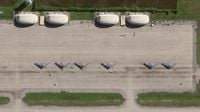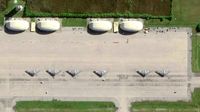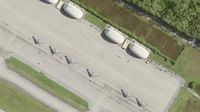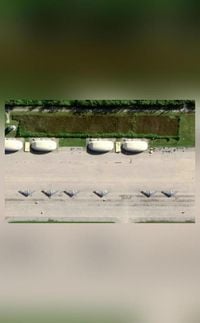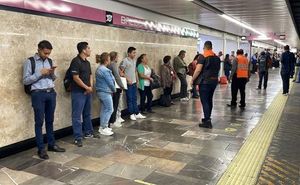In a significant military maneuver, the United States has deployed at least six B-2 stealth bombers to Diego Garcia, an island in the Indian Ocean, marking the largest-ever deployment of this advanced aircraft. This strategic move comes amid escalating tensions with Iran and ongoing military actions against Iran-backed Houthi rebels in Yemen, raising concerns about potential retaliatory strikes and the broader implications for regional stability.
Satellite imagery confirmed the presence of the B-2 bombers on the tarmac of the Diego Garcia airbase, a joint US-British facility located approximately 3,900 kilometers from Iran’s southern coast. This deployment represents about 30% of the US Air Force's total B-2 fleet, which consists of 20 bombers. The Pentagon has emphasized that this deployment is intended to enhance America’s defensive posture in the region and signal a strong deterrent message to Iran and its allies.
The deployment of the B-2s aligns with ongoing airstrikes targeting Houthi positions in Yemen, which have increasingly threatened US and commercial shipping in the Red Sea. President Donald Trump has made it clear that Iran will be held accountable for its support of these attacks. In a recent statement, he warned, "Stop shooting at US ships, and we will stop shooting at you. Otherwise, we have only just begun, and the real pain is yet to come for both the Houthis and their sponsors in Iran." This rhetoric underscores the seriousness with which the Trump administration views the threats posed by Iranian-backed forces.
Military analysts suggest that the B-2 bombers, known as the "ghosts of the sky," are among the most advanced military aircraft in the world, capable of evading radar and air defense systems. Each B-2 bomber, which costs approximately $2 billion, can carry a payload of 40,000 pounds and is equipped to conduct precision strikes on high-value targets. The aircraft's enhanced stealth and targeting capabilities make it particularly suited for bypassing Iranian air defenses, potentially allowing for effective strikes against key military installations.
Recent reports from the Pentagon’s Defense Intelligence Agency have highlighted the substantial arms smuggling from Iran to the Houthis, linking Tehran directly to attacks on US and commercial vessels in the region. This connection has further justified the US's military response, as the presence of B-2s serves as a warning that continued aggression could provoke limited retaliatory strikes, escalating into larger operations if necessary.
As part of this military escalation, the US has also increased its naval presence in the Indo-Pacific region, deploying three aircraft carriers, including the USS Nimitz and the USS Carl Vinson, to reinforce its strategic posture. This deployment is viewed by defense experts as a clear message not only to Iran and the Houthis but also to other regional powers like China and Russia, which are seen as allies of Tehran.
In the context of the ongoing conflict, the B-2 bombers have already been utilized in airstrikes against Houthi targets since March 15, 2025. The Air Force’s ability to employ the B-2s for precision strikes against deeply buried targets is significant, particularly given the Houthis' extensive network of underground facilities. The B-2 is currently the only US aircraft capable of deploying the 30,000-pound GBU-57/B Massive Ordnance Penetrator (MOP), a bunker-buster bomb designed for penetrating fortified structures.
Experts assert that the deployment of six B-2 bombers signifies a serious commitment to addressing the threats posed by the Houthis and their Iranian backers. Military aviation analyst Peter Layton noted, "Six is a serious number. For Houthi deeply buried targets, two or maybe three might be enough, but six B-2s is a major effort." This indicates that the US is prepared for a more extensive military engagement if necessary.
Furthermore, the Trump administration has set a deadline for Iran to return to the negotiating table regarding its nuclear program, with the President indicating that military action remains a possibility should diplomatic efforts fail. In a letter to Iranian Supreme Leader Ayatollah Ali Khamenei, Trump outlined a two-month timeframe for negotiations, stating, "There are two ways Iran can be handled: militarily, or you make a deal. I would prefer to make a deal because I am not looking to hurt Iran." However, Iran has thus far rejected direct negotiations, complicating the situation further.
As tensions continue to mount, the strategic deployment of B-2 bombers to Diego Garcia serves as a multifaceted signal: a deterrent to Iranian aggression, a show of force against the Houthis, and a broader message to regional rivals. The implications of this military buildup could have lasting effects on US-Iran relations and the stability of the Middle East.
In summary, the US's deployment of B-2 stealth bombers to Diego Garcia amidst ongoing military operations against the Houthis in Yemen highlights the seriousness of the situation in the region. With President Trump’s firm stance against Iran and the ongoing military actions, the potential for further escalation remains a pressing concern for all parties involved.
